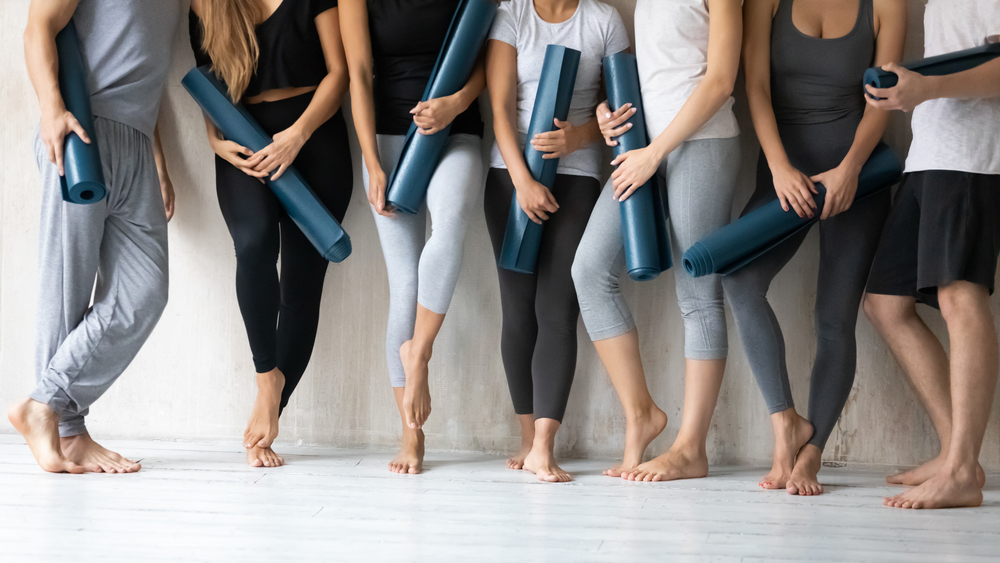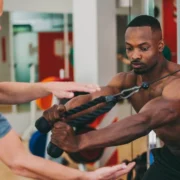Yoga Teachers and Studios Seek Shelter Online as Covid-19 Pulverizes Studios

Cassandra Daye and her husband opened Yoga Fire Studios in Indianapolis in the summer of 2019 and by fall, the studio seemed to be hitting a stride. Cooler weather drove up the demand for in-door recreation and the start of the school year allowed stay-at-home moms to take day classes.
The studio’s big sell was price, said Daye; membership cost $55 a month and drop-in classes ranged from $15 to $5. With a room that held 35 people, more students per class allowed for cheaper prices. Yoga Fire, which hired six instructors as independent contractors, broke even some months, a milestone for a new business.
On August 8, it closed its doors. The reason was, of course, the coronavirus. The studio was shut for almost three months during Indianapolis’ lockdown. When it reopened in late June, attendance was scant, sanitation efforts ate up staffers’ time and distancing regulations limited the room to 15 people — though the most populous classes only attracted seven or eight. The landlord demanded back rent for the months they were nonoperational. “We were just hemorrhaging money,” said Daye. She saw her only course was to close and wait until the crisis ends — whenever that will be — to find a new location.
As covid-19 infections surged across the summer, the business of yoga faced the reality that the pandemic was not a one-time battering of their finances. Reopenings have been hampered by regulations that have studios operating at a fraction of their capacity. Many students have not returned due to caution about the coronavirus transmission.
“There are businesses and teachers that have closed up and there are more to come,” said Kerry Maiorca, board chair of Yoga Alliance, the main governing body of yoga in the U.S. Most studios are trying to stay afloat with their limited cash reserves, she said, unsure and anxious about when they will turn a profit again.
In a global financial catastrophe that’s pulverized small businesses, yoga studios have a unique assortment of detriments. They sell spots in a room, so distancing — either mandated by law or social norm — limits their commodity. Facemasks, which also may be legally or socially mandated depending on the location, hamper enjoyment of the activity. The essential action of exhaling deeply can slingshot water particles, the most common carriers of the coronavirus. Students are not the only ones weary about returning; so are some teachers.
Claire Santos, who taught in a variety of settings in Charlotte, North Carolina, moved all her teaching online and says she would hesitate to step back into a studio until there is a vaccine for covid-19, that much-envisioned milestone that will put fears of hotspots and upticks into the past. “I wouldn’t put my own health or the health of someone else at risk,” Santos said.
Yoga instructors, who are mostly independent contractors, have lost gigs. But the career paths of yoga teachers vary widely, so the financial impact has differed for the ranks of instructors. Many are part-timers who have other jobs or funds. Lucky ones have lucrative consulting gigs or private clients they can continue remotely. Many full-time teachers divide time between various studios, gyms and organizations putting on yoga-in-the-park-type events and are struggling (even harder) to patch together a living.
A few teachers are working in studios that have reopened or, for the summer, outdoor spaces, said Maiorca. Others have taken an extended break, some because they don’t feel emotionally prepared to put on a calm aura.
Alecia Dawn Young of Pittsburgh, for example, shut down her studio and ceased taking in-person teaching gigs. She accepts some prenatal yoga clients online and works as a consultant for fitness businesses. But she’s mostly focused on her children, ages one and four and her family’s daily needs during the pandemic.
“It can be challenging to hold space for another person’s healing journey,” she said, “but I am extremely responsible about my own needs as a teacher myself and that’s meant reduced scheduling. I would like to teach several times a day [but] you can’t pour from an empty cup.”
Both studios and individual instructors have moved online, teaching classes via Zoom or Facebook Live or the yoga-specific service Namastream to students stationed safely in their homes. It’s a difficult business to navigate.
Yoga Fire held online classes with its regular teachers while Indianapolis was under lockdown. At no extra charge, members could log or anyone could pay a $5 drop-in fee. Daye said it was a struggle given the number of free instruction videos and per-donation classes available online. “We couldn’t compete with YouTube or studios that could afford to put on classes for free,” she said.
Other teachers have had better results. Santos said she is earning as much online as she did per class pre-pandemic. “I get less per person but I have more people logging on from all over the world,” she said. Her per-class haul is $100 to $150, the same as it ever was.
For an internet class, teachers have had to ask themselves: Should they charge? Accept donations? If they do charge, what’s the right price?
Maiorca said there are no easy answers: Teachers don’t want to price people out, due to sheer kindness or fear of being undercut by the availability of free videos and the donation-only teachers. Still, she said it’s important not be bowled over by circumstances to give up free labor. “I do think it’s important not to undervalue your service or education,” she said.
Maiorca said she is not worried about the practice losing popularity or moving online permanently because interest in has increased steadily since the introduction of yoga to Western audiences. A 2016 study, Yoga in America, conducted by the Yoga Alliance and Yoga Journal, found that 36.7 million Americans practice yoga. What’s more, people spent a total of $16.8 billion a year on classes, clothing and equipment that year, indicating a large market of committed class-goers, which she expects to rebound.
A Centers for Disease Control report, released in November of 2018, also found growth in yoga; 14.3 percent of U.S. adults said they practiced for health benefits in 2017, up from 9.5 percent in 2012.
“Interest is continually building,” said Maiorca. “Yoga used to be seen as something that happened in a gym, but it’s transitioned to specialty businesses.” She thinks the industry will go back its growth pattern, but some studios will shut down, temporarily or permanently, before it does.
The Yoga Alliance is hoping for some help from the federal government. Studios were largely ineligible for the Small Business Administration’s Paycheck Protection Program, which provided low-interest federal loans to businesses that kept paying employees through the time they were shut down. Because teachers are independent contractors, on paper, most studios have few or no employees. (Daye said she applied for a PPP loan for Yoga Fire, but was turned down because the studio technically has only one employee, a manager.) The Yoga Alliance is petitioning lawmakers to modify the next stimulus package for businesses that rely on contractors.
Until relief comes, it’s a matter of effort, commitment and pre-existing name recognition to stay in the business. “I think teachers who are well-committed, well-trained will find a way” said Maiorca. “Established teachers will find a way to survive.”
Nick Keppler is a freelance journalist, writer and editor. He enjoys writing the difficult stories, the ones that make him pore over studies, talk about subjects that make people uncomfortable, and explain concepts that have taken years to develop. Nick has written extensively about psychology, healthcare, and public policy for national publications and for those locally- based in Pittsburgh. In addition to Athletech News, Nick has written for The Washington Post, The Daily Beast, Vice, Slate, Reuters, CityLab, Men’s Health, The Gizmodo Media Group, The Financial Times, Mental Floss, The Village Voice and AlterNet. His journalistic heroes include Jon Ronson, Jon Krakauer and Norah Vincent.



